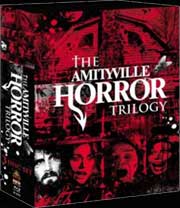 THE
AMITYVILLE HORROR TRILOGY (1979/1982/1983) (Blu-ray)
THE
AMITYVILLE HORROR TRILOGY (1979/1982/1983) (Blu-ray)Directors: Stuart Rosenberg/Damiano Damiani/Richard Fleischer
Scream Factory/Shout! Factory
 THE
AMITYVILLE HORROR TRILOGY (1979/1982/1983) (Blu-ray)
THE
AMITYVILLE HORROR TRILOGY (1979/1982/1983) (Blu-ray)New York’s most stigmatized property is the subject of Scream Factory’s first Blu-ray boxed set with THE AMITYVILLE HORROR TRILOGY.
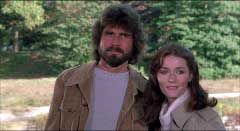
THE AMITYVILLE HORROR (1979) is the now familiar story of the Lutz family’s experiences living in a New York Dutch Colonial ocean-front house bought at a too-good-to-be-true price because of the mass murder of an entire family in its recent past. The first to realize that something is wrong with the house is Father Delaney (Rod Steiger, IN THE HEAT OF THE NIGHT) who is attacked by a swarm of flies and becomes violently ill when he later tries to contact the family to warn them (as does a visiting nun). Pretty soon, patriarch George (James Brolin, THE CAR) becomes short-tempered and sickly, daughter Amy (Natasha Ryan, THE ENTITY) has an invisible friend named “Jody”, son Greg (K.C. Martel, BLOODY BIRTHDAY) nearly loses his fingers when a window closes on them and refuses to open, and mother Kathy (Margot Kidder, BLACK CHRISTMAS) is just all-around hysterical.
 It’s
not a great synopsis, but I realized after re-watching this genre classic after
so many years that it’s doesn’t really hold up well. It’s
not boring – as some fans of the remake suggest – but it’s
hampered by its timeline structure chronicling the twenty-odd days before the
family fled the house in the middle of the night. Because of this need to stretch
the action out over a certain time frame without boring the audience, the characters
react (or over-react) in terror but are slow to do anything practical in the
aftermath of enough creepy occurrences (when the filmmakers could have tried
to ring some suspense out of anticipation). The story at the house is intercut
with that of Father Delaney and the meandering investigation of Sgt. Gionfriddo
(Val Avery, PAPILLON), both comparing poorly to their THE EXORCIST counterparts
(also a trained psychiatrist and hardboiled detective). The explanation for
the haunting – provided by George’s business partner’s conveniently
psychic wife (Helen Shaver, TREMORS) – isn’t the least compelling
and seems thrown together along with George’s resemblance to the man who
murdered his family the year before (the two men actually do not look that similar,
at least not as much as Brolin and his real life brother who doubled as the
killer in photographs and in the red room scene) just as George finally decides
to go axe-happy. The direction of Stuart Rosenberg (THE DROWNING POOL) lacks
conviction, and what effect the film does have is through the efforts of composer
Lalo Schifrin (DIRTY HARRY) – with his now iconic score – and the
cinematography of Fred J. Koenekamp (THE SWARM). The “true” story
is widely considered a hoax. While the case still has its hardcore believers,
the film and its follow-ups (including two books that followed the Lutz family’s
continued haunting away from the house and the increasingly tangential direct-to-video
sequels) are unlikely to convert skeptics (although the Jay Anson’s book
scared the hell out of me as a kid).
It’s
not a great synopsis, but I realized after re-watching this genre classic after
so many years that it’s doesn’t really hold up well. It’s
not boring – as some fans of the remake suggest – but it’s
hampered by its timeline structure chronicling the twenty-odd days before the
family fled the house in the middle of the night. Because of this need to stretch
the action out over a certain time frame without boring the audience, the characters
react (or over-react) in terror but are slow to do anything practical in the
aftermath of enough creepy occurrences (when the filmmakers could have tried
to ring some suspense out of anticipation). The story at the house is intercut
with that of Father Delaney and the meandering investigation of Sgt. Gionfriddo
(Val Avery, PAPILLON), both comparing poorly to their THE EXORCIST counterparts
(also a trained psychiatrist and hardboiled detective). The explanation for
the haunting – provided by George’s business partner’s conveniently
psychic wife (Helen Shaver, TREMORS) – isn’t the least compelling
and seems thrown together along with George’s resemblance to the man who
murdered his family the year before (the two men actually do not look that similar,
at least not as much as Brolin and his real life brother who doubled as the
killer in photographs and in the red room scene) just as George finally decides
to go axe-happy. The direction of Stuart Rosenberg (THE DROWNING POOL) lacks
conviction, and what effect the film does have is through the efforts of composer
Lalo Schifrin (DIRTY HARRY) – with his now iconic score – and the
cinematography of Fred J. Koenekamp (THE SWARM). The “true” story
is widely considered a hoax. While the case still has its hardcore believers,
the film and its follow-ups (including two books that followed the Lutz family’s
continued haunting away from the house and the increasingly tangential direct-to-video
sequels) are unlikely to convert skeptics (although the Jay Anson’s book
scared the hell out of me as a kid).
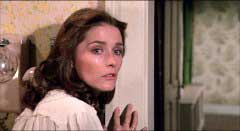
THE AMITYVILLE HORROR was previously released on Blu-ray by rights owners MGM in a barebones edition with a DTS-HD Master Audio 5.1 (the original mono track was included in a Dolby Digital 1.0 mix along with other language options). The theatrical trailer was the only extra. Scream Factory’s 1080p24 MPEG-4 AVC-encoded 1.85:1 encode likely derives from the same MGM HD master (and the pig looks even worse in HD). The original mono track is included here as DTS-HD Master Audio 2.0 track, and the 5.1 remix is also included in that format along with optional English SDH subtitles. Unlike the MGM Blu-ray, Scream Factory’s edition features a handful of extras; however, most of them are ported over from MGM’s own special edition DVD – replacing their non-anamorphic 2000 edition – released in 2005 in a single disc and as part of a boxed set with parts two and three, and in 2008 in a two-disc set with the horrid Platinum Dunes remake (a 2006 single disc double feature with THE FOG was also released but I don’t know about the specs).
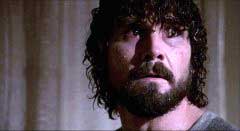 The
recycled extras includes the meandering audio commentary by late parapsychologist
Hans Holzer, author of the books “Murder in Amityville”, “The
Amityville Curse”, and “The Secret of Amityville”. Holzer
had nothing to do with the Lutz investigation (which unfortunately introduced
the public to the Warrens). He was reportedly contacted by Ronald DeFeo’s
attorney (after he had been convicted and sentenced). Holzer contended that
the house was built on an Indian burial ground, and that it is the land that
is disturbed not the house. While he believed that DeFeo may have been possessed,
he doubted much of the Lutz haunting and that the book deal may have been in
motion before the family fled the house (having been suggested to Lutz by a
priest asked to exorcise the house). He also did not believe that the haunting
force was demonic (and that the “pig eyes” may have actually been
a cat). He contended that the “true” story was interesting enough
without the Hollywood embellishments, and is amused by much of the film’s
highlights and spends much of the time pointing out what didn’t happen
(no bloody walls or devil worship). While I don’t particularly buy any
accounts of the haunting, Holzer’s own observations are questionable:
he describes George Lutz as a “benign man” but that jars with his
stepson’s accounts in the recent documentary MY AMITYVILLE HORROR (although
he admits the animosity went both ways, the tensions of the blended family was
barely addressed at all in the film).
The
recycled extras includes the meandering audio commentary by late parapsychologist
Hans Holzer, author of the books “Murder in Amityville”, “The
Amityville Curse”, and “The Secret of Amityville”. Holzer
had nothing to do with the Lutz investigation (which unfortunately introduced
the public to the Warrens). He was reportedly contacted by Ronald DeFeo’s
attorney (after he had been convicted and sentenced). Holzer contended that
the house was built on an Indian burial ground, and that it is the land that
is disturbed not the house. While he believed that DeFeo may have been possessed,
he doubted much of the Lutz haunting and that the book deal may have been in
motion before the family fled the house (having been suggested to Lutz by a
priest asked to exorcise the house). He also did not believe that the haunting
force was demonic (and that the “pig eyes” may have actually been
a cat). He contended that the “true” story was interesting enough
without the Hollywood embellishments, and is amused by much of the film’s
highlights and spends much of the time pointing out what didn’t happen
(no bloody walls or devil worship). While I don’t particularly buy any
accounts of the haunting, Holzer’s own observations are questionable:
he describes George Lutz as a “benign man” but that jars with his
stepson’s accounts in the recent documentary MY AMITYVILLE HORROR (although
he admits the animosity went both ways, the tensions of the blended family was
barely addressed at all in the film).
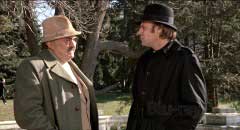
Also ported over is “For God’s Sake, Get Out!” (21:33) in which James Brolin and Margot Kidder recall their experiences on the film. Brolin was terrified by the book and thought the film came off well even if it fell short of the book. Kidder went into it for fun, maintaining that horror films are always verging on serious camp (she also remembers the ridiculous ideas of the publicity department for stories about on-set hauntings, and Rosenberg’s attempts to scare her with a pig puppet which had the opposite effect) and that the formula of horror movies makes them a great training ground for filmmakers. Separately interviewed, they both discuss how their approaches to acting in general – his rehearsal and memorization-oriented and hers more spontaneous – may have rubbed on another the wrong way, and Brolin admits that he went over the top in one scene (“I’m coming apart!”). Also carried over are the seven radio spots (3:38) and the theatrical trailer (2:30) seen on the MGM DVD, but Scream Factory has added a TV spot (0:59).
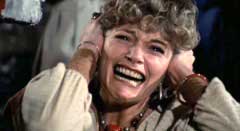 The
only new extra is an interview with the composer Lalo Schifrin (9:57) in which
he recalls seeing operas as a child as the inspiration for becoming a composer.
Schifrin had started collaborating with director Stuart Rosenberg in 1967 with
COOL HAND LUKE and scored four other projects for him in addition to THE AMITYVILLE
HORROR. He states that Rosenberg didn’t believe in the story, but he felt
he had to in order to effectively score it. Of the sequel, he only mentions
getting on well with Dino De Laurentiis. Had Shout! Factory released this edition
of THE AMITYVILLE HORROR alone, there would have been little reason to upgrade
if you already had the MGM Blu and DVD (unless you’re an A/V enthusiast
and wanted the film on a BD50 with a lossless encoding of the original mono
track) – the MGM special edition DVD can be picked up pretty cheaply used
– but the Scream Factory set does include that Blu-ray debuts of the series’
two other theatrical ventures.
The
only new extra is an interview with the composer Lalo Schifrin (9:57) in which
he recalls seeing operas as a child as the inspiration for becoming a composer.
Schifrin had started collaborating with director Stuart Rosenberg in 1967 with
COOL HAND LUKE and scored four other projects for him in addition to THE AMITYVILLE
HORROR. He states that Rosenberg didn’t believe in the story, but he felt
he had to in order to effectively score it. Of the sequel, he only mentions
getting on well with Dino De Laurentiis. Had Shout! Factory released this edition
of THE AMITYVILLE HORROR alone, there would have been little reason to upgrade
if you already had the MGM Blu and DVD (unless you’re an A/V enthusiast
and wanted the film on a BD50 with a lossless encoding of the original mono
track) – the MGM special edition DVD can be picked up pretty cheaply used
– but the Scream Factory set does include that Blu-ray debuts of the series’
two other theatrical ventures.
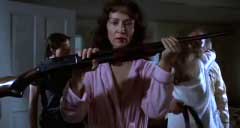
The Dino De Laurentiis-produced AMITYVILLE II: THE POSSESSION (1982) had little to do with the first film other than its marquee value, deriving its story from the speculative work “Murder in Amityville” by parapsychologist Hans Holzer based on one of Ronald DeFeo’s account of the murders which he claimed to have committed while possessed, and the discoveries Holzer made about the property that supported that theory. The film starts as the family – rechristened the Montellis – move into the house. Whereas the first film depicted a happy family (where there was apparently much tension), the Montelli family is dysfunctional from the start. Dad Anthony (Burt Young, ROCKY) is an authoritarian brute while mother Dolores (Rutanya Alda, CHRISTMAS EVIL) is a cowed peacekeeper (her aggressive response to Anthony’s abuse in one scene seems to be an effect of the forces in the house rather than her own nature). When I first saw the film, I thought Alda was even more over-the-top than Young, but re-watching does reveal a woman on edge from the start and appropriately overwrought (one can tell that she has apologized many times on behalf of her husband to her children, friends, and total strangers) while Young’s character appears to look for excuses to fly off the handle. Sonny’s (Jack Magner) signs of rebellion are only skin deep, and it seems natural for him to isolate himself (it’s too bad Magner never acted onscreen again after a small role in FIRESTARTER since he’s actually quite good here). Daughter Patricia (Diane Franklin, TERRORVISION) mirrors her mother while seeming to be unnaturally close to Sonny before his possession. The house could very well have let them destroy each other with a little patience, but the force in the basement (a creepy dungeon of a crawlspace rather than a dry well) makes mischief to escalate the existing tensions.
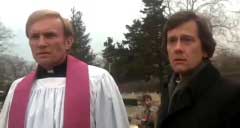 As
with the first film, a concerned priest Father Adamsky (James Olsen, CRESCENDO)
attempts to intervene with an exorcism – having observed the dysfunctional
behavior and taken a confession from Patricia that suggests things worse than
telekinesis – and meets resistance from the church bureaucracy (Leonardo
Cimino, DUNE) who are concerned about the image of the church in modern times
with exorcism seeming medieval and superstitious (a reference is also made to
complaints from parishioners about Adamsky, but it’s dropped quickly).
Here, he is too late, and the recreation of the DeFeo murders – while
technically inaccurate and sidestepping one of the real story’s actual
unanswered questions – is quite brutal less so for the onscreen bloodshed
than for its mercilessness (the shot of a possessed Sonny aiming his rifle at
his younger brother who thinks he’s hiding in a safe place is chilling).
It can only go downhill from this point, but the film fortunately gets its single
courtroom scene out of the way quickly before contriving a way for Adamsky to
get Sonny back to the house for the film’s exorcism which features some
impressive make-up effects work by John Caglione Jr. (C.H.U.D.). The ending
feels just as anti-climactic as the first film despite a not-so-surprising shock
ending, but it’s probably the most entertaining of the three (and possibly
of the entire series). Andrew Prine (SIMON, KING OF THE WITCHES) and Moses Gunn
(THE NINTH CONFIGURATION) have virtually nothing roles despite their prominent
billings.
As
with the first film, a concerned priest Father Adamsky (James Olsen, CRESCENDO)
attempts to intervene with an exorcism – having observed the dysfunctional
behavior and taken a confession from Patricia that suggests things worse than
telekinesis – and meets resistance from the church bureaucracy (Leonardo
Cimino, DUNE) who are concerned about the image of the church in modern times
with exorcism seeming medieval and superstitious (a reference is also made to
complaints from parishioners about Adamsky, but it’s dropped quickly).
Here, he is too late, and the recreation of the DeFeo murders – while
technically inaccurate and sidestepping one of the real story’s actual
unanswered questions – is quite brutal less so for the onscreen bloodshed
than for its mercilessness (the shot of a possessed Sonny aiming his rifle at
his younger brother who thinks he’s hiding in a safe place is chilling).
It can only go downhill from this point, but the film fortunately gets its single
courtroom scene out of the way quickly before contriving a way for Adamsky to
get Sonny back to the house for the film’s exorcism which features some
impressive make-up effects work by John Caglione Jr. (C.H.U.D.). The ending
feels just as anti-climactic as the first film despite a not-so-surprising shock
ending, but it’s probably the most entertaining of the three (and possibly
of the entire series). Andrew Prine (SIMON, KING OF THE WITCHES) and Moses Gunn
(THE NINTH CONFIGURATION) have virtually nothing roles despite their prominent
billings.
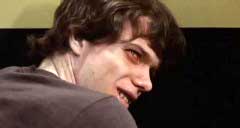
Lalo Schifrin returns and riffs on his score for the first film, but here it is the photography of Franco DiGiacomo (Dario Argento’s FOUR FLIES ON GREY VELVET) that is the film’s most striking aspect. THE EVIL DEAD seems to have been an inspiration on the visuals with more technically-polished versions of “the force” POV, camera shots that track towards and over characters and then turn 360 degrees, and then particularly impressive tracking shot that follows Sonny from the basement to his bedroom in the attic. The film’s camera operator was Daniele Nannuzzi, son of Armando Nannuzzi who shot SILVER BULLET and MAXIMUM OVERDRIVE for De Laurentiis (and unfortunately lost an eye in an on-set accident during the shooting of the latter film). Another impressive aspect of the production is the massive multi-story interior set of production designer Pierluigi Basile (DUNE) built at Mexico’s Churubusco Studios (the exteriors were shot at the same New Jersey location as in the original).
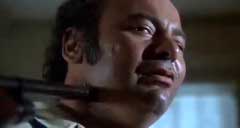 MGM
previously released AMITYVILLE II: THE POSSESSION on DVD in the aforementioned
Amityville boxed set and individually. The DVD was barebones with only an anamorphic
transfer, original mono audio, and the film’s theatrical trailer (the
UK got a commentary by critics Alan Jones and Kim Newman, as well as a photo
reconstruction of the deleted “lost souls” sequence). Fortunately,
Scream Factory’s 1080p24 MPEG-4 AVC 1.85:1 (not 1.78:1 as mentioned on
the cover) features an impressive-seeming package for the film (which also includes
the usual DTS-2.0 rendering of the mono track and a 5.1 upmix). Alexandra Holzer,
ghost hunter daughter of the late Hans Holzer, is on hand for a stilted commentary
track. Like her father, she points out what was Hollywood embellishment, what
“happened”, and what occurrences were at least possible (she has
yet to be on a case where blood ran from sink faucets). There are plenty of
pauses, but she does provide some interesting details about her father’s
involvement (the film was based on his book, after all) with the case and the
production. She reveals that it was he that sought out producers for a movie
deal after writing the book, and that he genuinely believed DeFeo might be possessed
and that he couldn’t divorce his emotions from the facts. She also mentions
some aspects of the real story that were not depicted here or mentioned in the
other films (the gift of the house to the family from the mother’s father
was more of a cause of tension than any strange occurrences). She says her father
was okay with some of the additions like the make-up effects transformations
because they visually conveyed how a possessed person would feel. She describes
some of the differences between the film and the book as well (the book correctly
depicted the killings while the film has a more dramatic sequence that leaves
bodies strewn all over the house, and of course there was no climactic exorcism)
and how amused her father was that the script swapped his character out with
a priest. She also relates some of her own reactions to seeing the film as a
child and now (she says the sequence where Sonny is taken over is inaccurate
but she still enjoys it as a viewer). Presumably the stiltedness of the track
has to do with her lack of preparation or unfamiliarity with the commentary
format, but Shout really should have brought up the feature audio during the
pauses.
MGM
previously released AMITYVILLE II: THE POSSESSION on DVD in the aforementioned
Amityville boxed set and individually. The DVD was barebones with only an anamorphic
transfer, original mono audio, and the film’s theatrical trailer (the
UK got a commentary by critics Alan Jones and Kim Newman, as well as a photo
reconstruction of the deleted “lost souls” sequence). Fortunately,
Scream Factory’s 1080p24 MPEG-4 AVC 1.85:1 (not 1.78:1 as mentioned on
the cover) features an impressive-seeming package for the film (which also includes
the usual DTS-2.0 rendering of the mono track and a 5.1 upmix). Alexandra Holzer,
ghost hunter daughter of the late Hans Holzer, is on hand for a stilted commentary
track. Like her father, she points out what was Hollywood embellishment, what
“happened”, and what occurrences were at least possible (she has
yet to be on a case where blood ran from sink faucets). There are plenty of
pauses, but she does provide some interesting details about her father’s
involvement (the film was based on his book, after all) with the case and the
production. She reveals that it was he that sought out producers for a movie
deal after writing the book, and that he genuinely believed DeFeo might be possessed
and that he couldn’t divorce his emotions from the facts. She also mentions
some aspects of the real story that were not depicted here or mentioned in the
other films (the gift of the house to the family from the mother’s father
was more of a cause of tension than any strange occurrences). She says her father
was okay with some of the additions like the make-up effects transformations
because they visually conveyed how a possessed person would feel. She describes
some of the differences between the film and the book as well (the book correctly
depicted the killings while the film has a more dramatic sequence that leaves
bodies strewn all over the house, and of course there was no climactic exorcism)
and how amused her father was that the script swapped his character out with
a priest. She also relates some of her own reactions to seeing the film as a
child and now (she says the sequence where Sonny is taken over is inaccurate
but she still enjoys it as a viewer). Presumably the stiltedness of the track
has to do with her lack of preparation or unfamiliarity with the commentary
format, but Shout really should have brought up the feature audio during the
pauses.
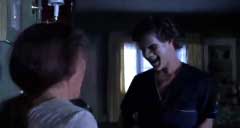
In "The Possession of Damiani" (6:07), director Damiano Damiani – who died this year – reveals that he felt less pressure on the film since it was not his script and the actors had already been cast (he took it because he wanted to stay in America a while longer). He talks about respecting the script but having his own vision of the film, and discusses his favorite shot of the film (he built some of the camera rigs for the film’s more adventurous shots). "Adapting Amityville" - interview with screenwrter Tommy Lee Wallace (12:26) said he was not interested in doing a sequel, so he pitched doing a prequel based on Holzer’s book. He got on well with De Laurentiis who he felt was both supportive and decisive (all decisions were ultimately De Laurentiis’ so Wallace could have his ideas either approved or quashed very quickly and move on), and that Damiani had heavy input into the exorcism scenes. Just about to direct his first film – HALLOWEEN III: SEASON OF THE WITCH – Wallace thought at the time that he could have done a better job directing the script himself, but now feels that Damiani did fine work on the film.
 In
"A Mother's Burden" actress Rutanya Alda (14:08) discusses landing
the role, shooting in Mexico (James Olsen took it upon himself to find the actors
a hotel free of earthquake damage), her affection for her fellow cast members,
and the film’s enduring popularity. In "Family Matters", actress
Diane Franklin (13:38) also conveys her surprise at the film’s continued
popularity. She reveals that the incest scene was easy since she didn’t
have a brother, and interpreted her character as being closer to Sonny than
her abusive father (Franklin also appears on the commentary and featurette on
Shout’s TERRORVISION/THE VIDEO DEAD Blu-ray/DVD combo as well as Arrow
Video’s upcoming Region B combo for THE LAST AMERICAN VIRGIN). In "Father
Tom's Memories" (3:42), actor Andrew Prine actually has little to say about
the film – he does have little to do in the film – other than expressing
his admiration of the actors (it may actually be an unused extract from the
Prine interview on THE TOWN THAT DREADED SUNDOWN). Alexandra Holzer appears
again in the interview “Continuing the Hunt” (28:45) in which she
is more laid-back and personable. She talks about “growing up haunted”
(also the title of her book). She discusses her father’s reaction to the
first film, the shooting of this film, the commercialization of his source novel,
his relationship with Ronald DeFeo (who apparently had unkind things to say
about Holzer once he was no longer useful), his published novels and unproduced
screenplays, his running commentary on the various series sequels when they
appeared on television, and his opinions on the current paranormal reality shows.
Besides the theatrical trailer (1:55) present on the MGM DVD, Shout adds a French
trailer (1:17) and a still gallery (which includes a lobby card with one of
the “lost souls” deleted shots). There is also a brief Easter Egg
(1:24) in which make-up artist Stephen Dupuis (SPASMS) recalls working with
Caglione Jr. and Ed French (NIGHTMARE) on the film’s make-up effects (and
Franklin’s “whore” make-up in the climax).
In
"A Mother's Burden" actress Rutanya Alda (14:08) discusses landing
the role, shooting in Mexico (James Olsen took it upon himself to find the actors
a hotel free of earthquake damage), her affection for her fellow cast members,
and the film’s enduring popularity. In "Family Matters", actress
Diane Franklin (13:38) also conveys her surprise at the film’s continued
popularity. She reveals that the incest scene was easy since she didn’t
have a brother, and interpreted her character as being closer to Sonny than
her abusive father (Franklin also appears on the commentary and featurette on
Shout’s TERRORVISION/THE VIDEO DEAD Blu-ray/DVD combo as well as Arrow
Video’s upcoming Region B combo for THE LAST AMERICAN VIRGIN). In "Father
Tom's Memories" (3:42), actor Andrew Prine actually has little to say about
the film – he does have little to do in the film – other than expressing
his admiration of the actors (it may actually be an unused extract from the
Prine interview on THE TOWN THAT DREADED SUNDOWN). Alexandra Holzer appears
again in the interview “Continuing the Hunt” (28:45) in which she
is more laid-back and personable. She talks about “growing up haunted”
(also the title of her book). She discusses her father’s reaction to the
first film, the shooting of this film, the commercialization of his source novel,
his relationship with Ronald DeFeo (who apparently had unkind things to say
about Holzer once he was no longer useful), his published novels and unproduced
screenplays, his running commentary on the various series sequels when they
appeared on television, and his opinions on the current paranormal reality shows.
Besides the theatrical trailer (1:55) present on the MGM DVD, Shout adds a French
trailer (1:17) and a still gallery (which includes a lobby card with one of
the “lost souls” deleted shots). There is also a brief Easter Egg
(1:24) in which make-up artist Stephen Dupuis (SPASMS) recalls working with
Caglione Jr. and Ed French (NIGHTMARE) on the film’s make-up effects (and
Franklin’s “whore” make-up in the climax).
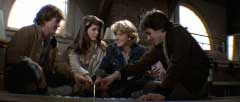
In AMITYVILLE 3-D – also known as AMITYVILLE: THE DEMON for its two-dimensional engagements (although 2-D VHS, laserdisc, and DVD releases have always used the 3-D title while disclaiming that those particular editions are not in 3-D) – tabloid journalist John Baxter (Tony Roberts, ANNIE HALL) and his partner Melanie (Candy Clark, Q: THE WINGED SERPENT) bust a fraudulent psychic couple operating out of the Amityville house, and John decides to buy the house as a place to write his great American novel. Despite the sudden death of the house’s realtor Sanders (John Harkins, BIRDY) in the house and the Melanie’s own horrific experiences while alone in the house, John remains skeptical. His ex-wife Nancy (Tess Harper, SILKWOOD) on the other hand has misgivings about the house and forbids their teenage daughter Susan (Lori Loughlin, THE NEW KIDS) to go there; so of course she and her friends (including a very photogenic Meg Ryan in her second feature) decide to go to the house and conduct a séance…
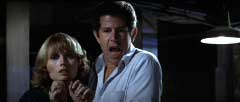 Like
AMITYVILLE II: THE POSSESSION, AMITYVILLE 3-D isn’t really a sequel to
either of the films before it. The house has a reputation, but there is no explicit
mention of the Lutz family’s experiences, and when Lisa recounts the murders
she uses the real surname DeFeo rather than the second film’s Montelli
family and her description is more factually accurate than the depiction in
the second film. AMITYVILLE 3-D was aimed at a wider audience and rated PG (even
Howard Blake’s score is more playful than suspenseful, telegraphic an
early false scare’s comic reveal). What potential jump scares the film
are diffused by the many stage actions the actors are forced to work into their
performances to exploit the 3-D gimmick (although not quite as ridiculously
as in FRIDAY THE 13TH PART III: 3-D). The finale involves an investigation of
the house by parapsychologist Elliot West (Robert Joy, THE DARK HALF) and his
crew, offering as many opportunities for electronic measuring instruments jabbed
towards the camera as it does for bodies flying at the camera (and projectiles
flying at the bodies) during the obligatory conflagration. The final demon seems
to be somewhat of a cross between effects artist John Caglione Jr.’s creation
for the finale of the first film and one of his C.H.U.D.s. The film utilizes
the same Churubusco studio set as the previous installment with additional production
design work by Giorgio Postiglione (CAT’S EYE).
Like
AMITYVILLE II: THE POSSESSION, AMITYVILLE 3-D isn’t really a sequel to
either of the films before it. The house has a reputation, but there is no explicit
mention of the Lutz family’s experiences, and when Lisa recounts the murders
she uses the real surname DeFeo rather than the second film’s Montelli
family and her description is more factually accurate than the depiction in
the second film. AMITYVILLE 3-D was aimed at a wider audience and rated PG (even
Howard Blake’s score is more playful than suspenseful, telegraphic an
early false scare’s comic reveal). What potential jump scares the film
are diffused by the many stage actions the actors are forced to work into their
performances to exploit the 3-D gimmick (although not quite as ridiculously
as in FRIDAY THE 13TH PART III: 3-D). The finale involves an investigation of
the house by parapsychologist Elliot West (Robert Joy, THE DARK HALF) and his
crew, offering as many opportunities for electronic measuring instruments jabbed
towards the camera as it does for bodies flying at the camera (and projectiles
flying at the bodies) during the obligatory conflagration. The final demon seems
to be somewhat of a cross between effects artist John Caglione Jr.’s creation
for the finale of the first film and one of his C.H.U.D.s. The film utilizes
the same Churubusco studio set as the previous installment with additional production
design work by Giorgio Postiglione (CAT’S EYE).
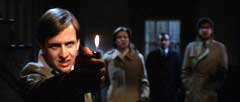
Scream Factory’s disc features 1080p24 MPEG-4 AVC widescreen (2.35:1) encodings of the film in 2D and 3-D. There is no set-up option to select either version; the 3-D is automatically selected if you have the appropriate equipment (and the 2D version can be accessed by turning the 3-D mode off). I do not have a 3-D player or television, so I went with the 2D version. The film was shot in the ArriVision 3-D process (the same process used around this time for FRIDAY THE 13TH PART III, JAWS 3-D, and EMMANUELLE IV) which used a beam splitter to capture two images on a single strip of film (one on the top two perforations and one on the bottom two, almost like the 2-perf Techniscope process without the benefit of shooting twice as much footage per roll of film). The resulting image seems to have always been sharper in the center and soft-to-blurry along the edges of the frame (even shots that are denoted as having been shot with wide-angle lenses not by their coverage but by the bowing of straight lines – which should have a larger depth of field at any aperture than a long lens – are softish on the sides). I’ve been informed that Scream Factory’s 3-D transfer of the film is new, but it also appears that the 2D version is also a new transfer. There’s no MGM logo attached to the start of the transfer as there is on the DVD, and the title cards are differently designed and animated (although even the 2D DVD uses a 3-D title). The 5.1 upmix sounds better than those of the previous films because AMITYVILLE 3-D also went bigger with a Dolby Stereo mix (which is available as a DTS-HD Master Audio 2.0 option). English SDH subtitles are also included with minimal errors.
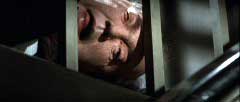 If
you don’t consider the 3-D version of the film as an extra (or the 2D),
then the extras package for the third film is most disappointing of all. Other
than the trailer – the same thirty-eight second teaser from the DVD –
and a still gallery, the disc only features an interview with actress Candy
Clark (9:45) who talks about the mostly enjoyable experience of shooting in
Mexico (although her wardrobe was lost in customs and her legs cramped up climbing
a pyramid so they shot the séance sequence first so she would be sitting
down most of the time), and acting out her death scene. Director Richard Fleischer
– who also directed MANDINGO, BARRABAS, and CONAN THE DESTROYER for De
Laurentiis – did an interview about the film before his death in 2006
that was published a few years ago in Video Watchdog. The three discs come in
individual Blu-ray keep cases with (thankfully) their original poster art in
an attractive red, white, and black slipcase. The reverse of the covers is the
usual Shout collage of posters and stills. As with most Scream Factory releases,
the individual covers and the slipcase seem to have been planned well ahead
of the actual disc releases since there is no mention of Schifrin’s score
on the first, the Tommy Lee Wallace and Alexandra Holzer interviews on the second
(or the 5.1 track), and the Candy Clark interview on the third (the cover of
which only mentions the 5.1 track and not the 2.0 option). (Eric
Cotenas)
If
you don’t consider the 3-D version of the film as an extra (or the 2D),
then the extras package for the third film is most disappointing of all. Other
than the trailer – the same thirty-eight second teaser from the DVD –
and a still gallery, the disc only features an interview with actress Candy
Clark (9:45) who talks about the mostly enjoyable experience of shooting in
Mexico (although her wardrobe was lost in customs and her legs cramped up climbing
a pyramid so they shot the séance sequence first so she would be sitting
down most of the time), and acting out her death scene. Director Richard Fleischer
– who also directed MANDINGO, BARRABAS, and CONAN THE DESTROYER for De
Laurentiis – did an interview about the film before his death in 2006
that was published a few years ago in Video Watchdog. The three discs come in
individual Blu-ray keep cases with (thankfully) their original poster art in
an attractive red, white, and black slipcase. The reverse of the covers is the
usual Shout collage of posters and stills. As with most Scream Factory releases,
the individual covers and the slipcase seem to have been planned well ahead
of the actual disc releases since there is no mention of Schifrin’s score
on the first, the Tommy Lee Wallace and Alexandra Holzer interviews on the second
(or the 5.1 track), and the Candy Clark interview on the third (the cover of
which only mentions the 5.1 track and not the 2.0 option). (Eric
Cotenas)